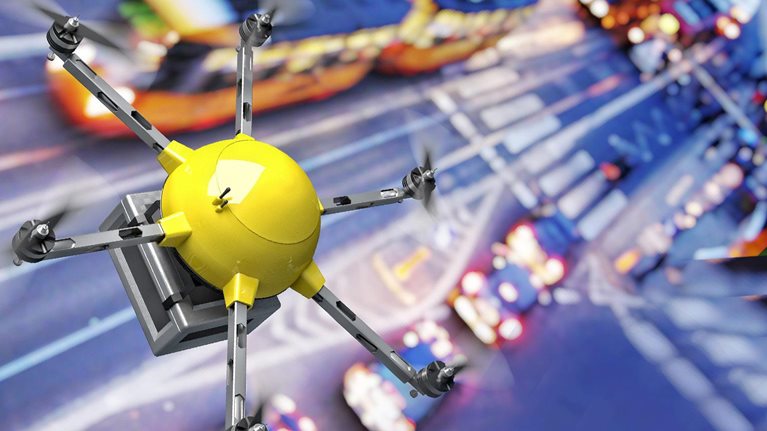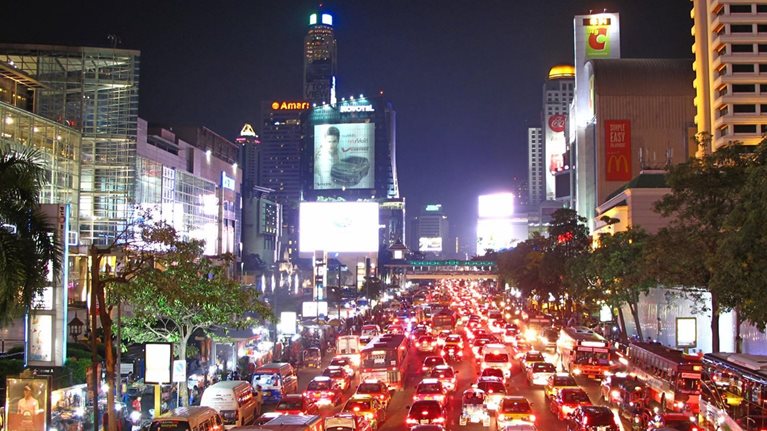The age of modern transit began in 1863, when the first underground railway began rolling in central London. The line was short and smoky, and nothing like it had ever been seen before. But it worked, and cities around the world began to follow London’s lead. Over time, city authorities came to see providing transportation as one of their core responsibilities; governments often owned and ran transit systems themselves.
Despite governments’ best efforts, traffic is getting worse in many cities, and urban mobility has become increasingly complex. From 2010 to 2016, congestion rose in London by 14 percent, in Los Angeles by 36 percent, in New York by 30 percent, and in Beijing and Paris by 9 percent. Congestion carries health consequences, in the form of accidents and air pollution. Demographic trends—more people, and more in urban areas—will accentuate today’s strains, which aren’t solely about the movement of people. E-commerce is also growing fast, adding to the demand for urban commercial transport.
The technological changes associated with mobility’s “second great inflection point” create myriad opportunities for cities to address these challenges. As ridesharing grows up, digital vehicle connectivity deepens, electric vehicles (EVs) become mainstream, and autonomous vehicles (AVs) take hold (see “The trends transforming mobility’s future”), it becomes possible to envision a future of “seamless mobility.” In such an environment, the boundaries among private, shared, and public transport would be blurred, and travelers would have a variety of clean, cheap, and flexible ways to get from point A to point B. Our analysis suggests that seamless mobility could be cleaner, more convenient, and more efficient than the status quo, accommodating up to 30 percent more traffic while cutting travel time by 10 percent.
Today’s reality, though, is far from seamless. Vehicles that are fully autonomous do not yet exist in meaningful numbers, EVs still make up only a small percentage of the global vehicle fleet, and traditional internal-combustion-engine (ICE) cars represent about 40 percent of passenger-kilometers—often more than rail and bus services combined.
Starting from this baseline, urban-mobility systems in dense, developed cities, such as London, New York, and Seoul, could evolve in a variety of ways over the next dozen years. This article describes three potential scenarios and details how public- and private-sector leaders can forge a strategy to make seamless mobility happen. For city planners and other urban-mobility specialists, we have also prepared a longer report, An integrated perspective on the future of mobility, part 3: Setting the direction toward seamless mobility (PDF–4.5MB).
Three scenarios
To develop a perspective on the future, we modeled a set of short (fewer than two kilometers), medium (two to ten kilometers), and long (more than ten kilometers) trips, differentiating between trips within the city business district and trips to and from the city and the suburbs. We also simulated the trade-offs that people make—for instance, deciding between a more convenient but pricier autonomous shuttle and a less convenient but cheaper bus—and estimated how these decisions could affect congestion in 2030. Finally, we accounted for “induced travel”—the concept that when it is easier or cheaper to travel, demand tends to rise. This analysis shows that seamless mobility holds many advantages, but achieving it is far from a foregone conclusion.
Scenario 1: Business-as-usual urbanization
Imagine a world in which population growth continued, but large cities managed their transport systems largely as they do today, with little innovation in pricing or policy. Imagine further that complicated traffic patterns, setbacks in technology development, and delays in consumer adoption deterred the large-scale deployment of AVs, and that vehicles did not electrify in large numbers.
In our analysis of such a model, the results are discouraging. Transport demand would increase in line with population growth (about 15 percent by 2030), and greenhouse-gas (GHG) emissions could rise proportionally. City dwellers would travel in mostly the same ways as they do now, and private cars would continue to account for about 35 percent of passenger-kilometers. Average travel times would increase by 15 percent because capacity would be strained. In the United States, without substantial change, this is the likely scenario: few cities, even the largest, have comprehensive plans that consider new and forthcoming technologies.
Scenario 2: Unconstrained autonomy

Now consider an alternative future in which autonomous-driving technology advances, but regulators and city governments don’t keep up. In other words, what if autonomous-transportation options follow in the footsteps of bikesharing programs and e-hailing, which hit the roads faster than the policies needed to guide them did?
It’s certainly plausible. By 2030, shared AVs—or robo-taxis—could navigate to, from, and within a central business district. Our analysis suggests that, at that point, they could become an attractive alternative to private-vehicle ownership, with the cost per mile of riding in a robo-taxi running about the same as the cost of owning a moderately priced private vehicle, and that travelers could adopt them for individual or shared use for about 35 percent of their travel by 2030.
Compared with the first scenario, this one has clear advantages. The partial displacement of fixed-route buses by robo-taxis with flexible routing would increase the share of point-to-point trips, reducing waiting and walking times between transfers. If the robo-taxis were electric, GHG emissions would fall and air quality improve. Congestion, however, will not improve compared with the baseline, and it could get worse. The average time for a private car trip could increase as an increased convenience of robo-taxis draws more users onto the roads. Other travelers, anxious to avoid the crowded roads, could pack into trains. In all, we estimate that average travel times would be 15 percent higher compared with today’s baseline scenario.
Scenario 3: Seamless mobility
Now for a third possibility: What if cities encourage the use of shared AVs through regulation and incentives? That would make it possible for residents to “mix and match” rail transit and low-cost, point-to-point autonomous travel in robo-taxis, autonomous shuttles, and autonomous buses easily.
Our analysis suggests that pooled AV shuttles could grab 25 percent of the market (twice as much as in the unconstrained-autonomy scenario), and private cars and privately used robo-taxis could provide about 30 percent of passenger-kilometers in 2030, compared with 35 percent for private cars today (Exhibit 1).

It’s not just autonomous vehicles that would make the difference. Intelligent traffic systems, advanced rail signaling, and connectivity-enabled predictive maintenance would all boost network reliability. Seamless mobility could improve performance on all five indicators that characterize a transit system: availability, affordability, efficiency, convenience, and sustainability. It could accommodate up to 30 percent more passenger-kilometers (availability) while reducing average time per trip by 10 percent (efficiency). It could cost 25 to 35 percent less per trip (affordability), increase the number of point-to-point trips by 50 percent (convenience), and, if AVs are electric, lower GHG emissions by up to 85 percent (sustainability).
Setting the direction toward seamless mobility
The dramatic differences in outcomes associated with these scenarios (Exhibit 2) mean that cities, the companies operating in them, and their citizens face critical choices. Logistics costs, employee productivity, and the day-to-day life experiences of urban employees and customers are all on the line. To get to seamless mobility—the most attractive but also the most complex end-state—cities must do three things well: optimize supply, optimize demand, and improve sustainability. Here’s a short list of urban transit priorities worth paying attention to.

Supply: Capacity utilization
Cities can enhance supply the traditional (and expensive) way—by building more roads, bridges, rail lines, and other infrastructure. But they can also do so by using their existing assets more intensively. Here are some tools they can deploy to do the latter:
- Paving the way for AVs. Priorities for enabling AV use range from simple-sounding ones, such as ensuring that roads have clear signage and are in good repair, to others involving careful coordination at local, state, national, and international levels—such as the synchronization of insurance regulations, safety rules, data standards, and communication protocols. The latter can actually boost road capacity, because allowing AVs to communicate with one another enables them to drive closer together, meaning more vehicles can travel safely on the same roads.
- Automating, and tech enabling, trains. Autonomous operations and advanced signaling reduce the space between train coaches, making it possible to achieve higher speeds and carry more people. This is no fantasy: dozens of autonomous trains already exist, for both metro lines and site-specific systems, such as airports. When Paris automated its oldest metro line, the average speed rose 20 percent. Trains can keep rolling more frequently through condition-based and predictive maintenance, which involve collecting performance data and using statistics to identify and fix problems before they cause breakdowns (reducing maintenance costs by up to 15 percent).
- Deploying intelligent traffic systems. These systems minimize wait times and maximize movement—for example, through lights that sense traffic and communicate with each other, as well as dynamic lane allocation, which shifts lanes to the direction with more traffic. Such systems have reduced commuting times in Buenos Aires by as much as 20 percent, in San Jose and Houston by 15 percent, and in Mumbai by 12 percent.
- Creating smart parking-technology networks. Such networks connect vehicles to infrastructure and inform users where parking is available, reducing the amount of time (and frustration) needed to find a space. In San Francisco and Johannesburg, smart parking has already reduced parking search times by about five minutes.
Would you like to learn more about our Sustainability & Resource Productivity Practice?
Demand: From private to shared modes of travel
Increasing supply alone won’t achieve seamless mobility. Encouraging people to shift to a widening array of shared-transportation options and moving some traffic to off-peak hours are also critical pieces of the puzzle. If people move away from driving themselves to using rail, bus, or autonomous shuttles, existing infrastructure can carry more passengers without increasing congestion—and maybe reducing it. Demand-optimization tools include the following:
- Creating dedicated lanes for shared vehicles. If all the autonomous shuttles and buses that enter circulation travel in their own lanes, they will be faster, more attractive travel options. Cities such as Bogotá and Brussels have already found this to be the case with traditional buses.
- Scaling e-scooters and shared bicycles. By shortening the “last mile” journey from a person’s location to a rail station, these options make rail travel more attractive. They are already correlated with increased public-transit usage in Beijing, Melbourne, and New York.
- Changing the terms of trade. Shared- and off-peak-transportation options become more attractive when individual, peak-load options are less enticing. For instance, limiting the number of robo-taxis and taxis, by way of a licensing system, increases wait times and would make users more likely to select shared, autonomous options. Congestion pricing, in which vehicles pay to enter busy urban areas at certain times, is another option. Such pricing has already succeeded at shifting traffic patterns in London, Milan, Singapore, and Stockholm.
- Shifting commercial deliveries to off-peak hours. Goods transport accounts for almost 20 percent of urban congestion. By allowing night deliveries, cities could take stop-and-go commercial vehicles off the streets during the day. The concept has been piloted in cities such as Barcelona and New York, reducing travel times for all users by as much as five minutes.
Sustainability: Congestion and air quality
Even with seamless mobility, roads would continue carrying the largest percentage of passengers and a healthy volume of freight. Improving air quality and reducing GHG emissions, therefore, means dealing with the vehicles that move on those roads. EV emissions fall sharply when they are charged with low- or no-emissions sources; they are therefore a critical part of the equation. One tool that cities can use to encourage the use of EVs is the creation of low- or zero-emissions zones. Another is to promote the electrification of shared, fleet, and government vehicles, which are used more intensively. Amsterdam has already made special citywide parking permits available for electric-car-sharing fleets, and Los Angeles International Airport recently purchased electric buses for its operations.

Urban commercial transport and the future of mobility
In our view of a seamless-mobility world, all robo-taxis and autonomous shuttles would be electric and charged by no-emissions sources by 2030. This may appear ambitious, given the baseline. Even in China, the world leader in EVs, only 30 percent of buses sold in 2016 were electric. As for cars, electric versions account for a tiny share of the global market, largely because of concerns about cost and range. However, because robo-taxis and autonomous shuttles are likely to be used more intensively and frequently as part of fleets, the total cost of ownership of an EV could become competitive with that of an ICE vehicle by the mid-2020s.
A possible dream
Achieving seamless mobility won’t be easy, but it’s not a pipe dream, because the advantages associated with it are so clear. Moreover, seamless mobility could create significant business opportunities. Our analysis suggests that by 2030, 40 percent of the transportation-revenue pool—the money that residents in dense, developed cities like New York, Paris, and Tokyo spend on transit—could be served by modes of transport (particularly autonomous shuttles, robo-taxis, and those using logistics approaches) that don’t even exist now. Seamless mobility may require new kinds of assets, such as storage and maintenance facilities for shared autonomous fleets, fast-charging infrastructure, and dedicated AV lanes equipped with vehicle-to-infrastructure communications and IT systems. All of this represents a significant new area of opportunity for infrastructure companies to design, build, and operate in and for new forms of public–private partnerships. Seamless mobility is only achievable if cities tap into the private sector’s capabilities, business models, innovations, and technologies.
Finally, the past offers hope. Cities have reimagined transport before and did what was necessary to improve the mobility, and thus the lives, of their people. Go back to that first underground railway: London not only permitted eight years of construction through one of the most crowded districts in the city, but it also established a public–private partnership and invested £200,000 in what was then a highly experimental project. “Those who devised and carried out this undertaking would be entitled to the highest praise and gratitude of the people,” noted one speaker at the ceremony to commemorate the opening. “This line was not only an honor to the country but a solid advance in civilization.” True enough then—and, perhaps, it will be true again in the future.
Download An integrated perspective on the future of mobility, part 3: Setting the direction toward seamless mobility, the full report on which this article is based (PDF–4.5MB).
CGI illustrations created expressly for McKinsey by Peter Crowther


